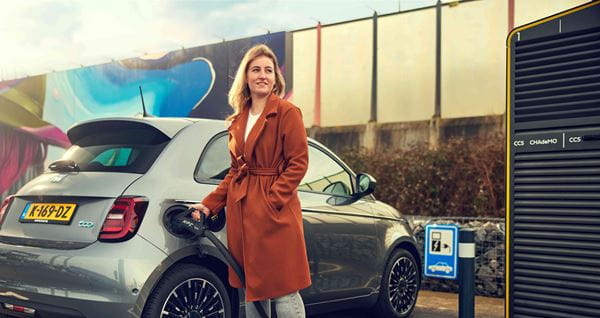
Europe’s low-emission zones: Which cars are allowed?
The internal combustion engine (ICE)’s days are numbered: the EU is banning the sale of petrol and diesel vehicles from 2035 onwards. As that date moves ever closer, European nations are bringing in a range of measures to curb the use of polluting vehicles.
This blog was originally published by ALD Automotive | LeasePlan, now Ayvens.
One popular policy is the introduction of low-emission zones (LEZs) and ultra-low-emission zones (ULEZs), under which access to city centres is restricted for certain types of vehicles. These zones also form part of the EU’s ambitious ‘Fit for 55’ project, which aims to reduce greenhouse gas emissions by 55% by 2030 compared to 1990 levels.
With this legislation constantly evolving, it’s important to stay on top of the latest developments – so we’ve put together a list of LEZ and ULEZ regulations in Europe’s top capital cities. It’s not just important to know where low emissions zones are at home but also abroad, especially if you like to go on road trips or rent a car on holiday.
London. UK
- Which vehicles face restrictions?
LEZ : Larger vans and minibuses, buses, coaches over 5 tonnes, trucks and specialist heavy vehicles over 3.5 tonnes.
ULEZ: Motorcycles, motor tricycles, quadricycles, cars, private-hire vehicles, small vans, larger vans and minibuses
- Are foreign vehicles affected?
Yes. Foreign vehicles need to register with Transport for London (TFL) and pay the daily charge if the vehicle does not meet emission standards.
Paris, France
- Which vehicles face restrictions?
LEZ : All cars entering the zone must meet the minimum standard: a B emission sticker. There are exemptions for trucks, vans, motorcycles, mopeds, historic vehicles, emergency vehicles and transport for people with disabilities.
ParkingLEZ: Depending on your emissions sticker, parking rates vary in this zone
- Are foreign vehicles affected?
Yes. Foreign vehicles need to meet the minimum standard, although there’s no obligation to display an emissions sticker.
Lisbon, Portugal
- Which vehicles face restrictions?
LEZ : Lisbon’s LEZ is divided into two sections: Zone 1 and Zone 2. Both are active on working days from 7am to 9pm. In Zone 1, vehicles must meet the Euro 3 emissions standard to enter. In Zone 2, vehicles must meet the Euro 2 standard. Vehicles weighing more than 7.5 tonnes cannot enter either zone during active hours.
Limited traffic zone: This is active on working days from 10am to 8pm, and from 1am to 8am. During these hours, only vehicles with a green, red or blue sticker are allowed to enter
- Are foreign vehicles affected?
Yes. All regulations apply to foreign vehicles.
Brussels, Belgium
- Which vehicles face restrictions?
LEZ : As of January 2022, petrol vehicles in the LEZ must meet a minimum emissions standard of Euro 2. Diesel vehicles must meet a minimum standard of Euro 5. Regulations apply on working days between 7am and 9pm
Zero-emission zone: Only vehicles with an electronic badge can enter this zone. The following are eligible for the badge: garage owners in the zone, vehicles of companies situated in the zone, medical care vehicles, deliveries of perishable goods and transport for people with disabilities. In special cases, such as weddings and moving house, individuals can apply for a temporary numerical code.
- Are foreign vehicles affected?
Yes, all foreign vehicles are affected. You can register here.
Amsterdam, The Netherlands
- Which vehicles face restrictions?
LEZ : To enter the zone, diesel passenger cars, diesel delivery vans, campervans and motorhomes must meet a minimum standard of Euro 4. Diesel trucks, as well as buses and coaches, must meet a minimum standard of Euro 6. This zone is active 24 hours a day, 365 days a year.
- Are foreign vehicles affected?
Yes. Those with foreign vehicles should contact the City of Amsterdam’s information line: +31 20 624 1111 if calling from outside the Netherlands, and 14 020 if calling from inside the Netherlands.
Berlin, Germany
- Which vehicles face restrictions?
LEZ : Any vehicle entering this zone needs to display a green sticker. For diesel vehicles, this means meeting the minimum standard of Euro 4. For petrol vehicles, a minimum standard of Euro 1 is required. Vehicles that do not meet these standards can be retrofitted with a particulate filter in order to qualify. This zone is active 24 hours a day, 365 days a year.
- Are foreign vehicles affected?
Yes. These regulations apply to foreign vehicles. To purchase an emissions sticker for Berlin, click here.
Vienna, Austria
- Which vehicles face restrictions?
LEZ : All trucks and heavy goods vehicles must meet a minimum emissions standard of Euro 3 in order to enter. This zone is active 24 hours a day, 365 days a year.
- Are foreign vehicles affected?
Yes, Foreign vehicles need to display an emissions sticker, which can be bought from one of the workshops listed here.
Rome, Italy
- Which vehicles face restrictions?
LEZ : Rome’s LEZ is divided into three sections: the green zone, the railway ring and the city centre. In the green zone, petrol vehicles must meet the Euro 2 standard, while diesel vehicles must meet the Euro 3 standard. In the railway ring, petrol vehicles must meet the Euro 3 standard and diesel vehicles the Euro 4 standard, while diesel mopeds and motorcycles must meet the Euro 2 standard. Both these zones are active midnight to midnight, Monday to Friday. In the city centre, petrol cars must meet the Euro 2 standard and diesel cars the Euro 4 standard. For full details of restrictions in Rome’s city centre, click here.
- Are foreign vehicles affected?
Yes, Foreign vehicles must meet the same standards to access LEZs in Rome.
Oslo, Norway
- Which vehicles face restrictions?
Emergency measure: During times of high pollution, Oslo bans diesel-powered passenger cars, vans, trucks and buses that do not meet Euro 6 emissions standards. Moreover, the city can close municipal car parks within a ‘red zone’.
- Are foreign vehicles affected?
Yes. Temporary bans on diesel vehicles apply to foreign vehicles as well.
Copenhagen, Denmark
- Which vehicles face restrictions?
LEZ: Buses and trucks must have been registered on or after 2015 to access the LEZ. Older diesel vehicles can still enter the zone if they have a particulate filter installed.
- Are foreign vehicles affected?
Yes. If a non-Danish van, truck or bus was registered before 2015, the vehicle must be registered with documentation for a particulate filter. Non-Danish vehicles must complete this registration no later than the day of entry into Copenhagen's LEZ.
Stockholm, Sweden
- Which vehicles face restrictions?
LEZ: All passenger cars, minibuses and vans entering this area must meet a minimum emissions standard of Euro 6. Vehicles meeting these standards don’t need to display a sticker; older vehicles with exemptions need to display a sticker. This zone is active 24 hours a day, 365 days a year.
Truck and bus LEZ: In the city centre, all trucks and buses must meet an emissions standard of Euro 6.
- Are foreign vehicles affected?
Yes. All foreign vehicles must meet these same standards
Helsinki, Finland
- Which vehicles face restrictions?
LEZ: Local buses and waste disposal trucks must meet a minimum emissions standard of Euro 5 to operate in this area at any time.
- Are foreigner vehicle affected?
No. This regulation only applies to local vehicles.
Prague, Czech Republic
- Which vehicles face restrictions?
Truck LEZ: Vehicles weighing more than 3.5 tonnes need to apply for a permit to enter the zone. This area is extended for vehicles above 6 and 12 tonnes. To receive a permit, a vehicle must meet the Euro 4 emissions standard. There are plans to introduce an LEZ for other vehicles, but this has not been enacted yet.
- Are foreign vehicles affected?
Yes, Foreign vehicles must also apply for a permit.
Budapest, Hungary
- Which vehicles face restrictions?
Protected and restricted zone: Budapest has 11 protected zones where no traffic of any kind is allowed. There are also 15 restricted zones for which heavy-duty vehicles need a permit to enter. To see a full list, click here.
- Are foreign vehicles affected?
Yes, these regulations apply to foreign vehicles.
How do EVs fit into the picture?
As you can see, there’s already a long list of regulations for ICE vehicles in European cities – and that list is only going to grow. EVs are exempt from almost all these restrictions, so if you want to save yourself the hassle of complying with LEZs all over Europe, there’s one simple solution: go electric!
Our net-zero commitment
LeasePlan is leading the transition to zero-emission mobility and has set itself the goal to achieve net-zero tailpipe emissions from its funded fleet by 2030. As a founding member of the EV100 – a global initiative of forward-looking companies committed to accelerating the transition to EVs – sustainable mobility is at the heart of everything we do.















.jpg?rev=ad671359e66c4d16a7139538e50c3234&mw=600)

